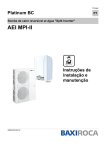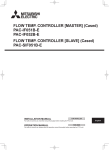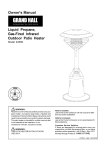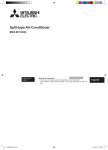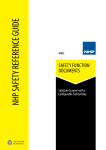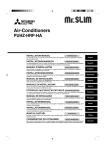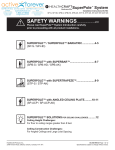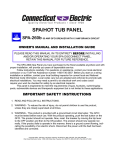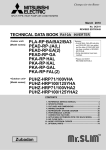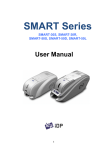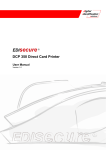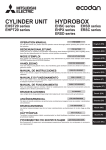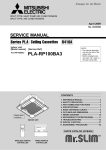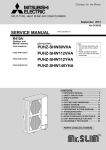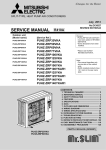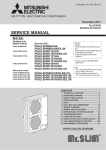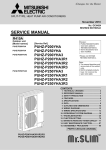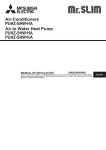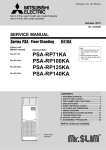Download FLOW TEMP. CONTROLLER 2B (Cased) PAC-IF032B-E
Transcript
FLOW TEMP. CONTROLLER 2B (Cased) PAC-IF032B-E INSTALLATION MANUAL FOR INSTALLER For safe and correct use, read this manual thoroughly before installing the FTC2B unit. OPERATION MANUAL FOR USER For safe and correct use, please read this operation manual thoroughly before operating the air-conditioner unit. English Contents 1. 2. 3. 4. 5. Safety precautions......................................................................................2 Installing the FTC2B unit............................................................................ 3 System.......................................................................................................4 Electrical work............................................................................................9 Dip switch setting.....................................................................................17 6. Before test run..........................................................................................22 7. Remote controller operation.....................................................................23 8. Troubleshooting........................................................................................30 9. Supplementary information......................................................................32 Local application factors.................................................................................33 “FTC2B” is the abbreviation of “Flow Temperature Controller 2B”, which is described as “FTC2B” in this manual. Mitsubishi Electric is not responsible for the failure of locally supplied parts. 1. Safety precautions Before installing the FTC2B unit, make sure you read all the “Safety precautions”. Please report to your supply authority or obtain their consent before connecting this equipment to the power supply system. Warning: Precautions that must be observed to prevent injuries or death. Caution: Precautions that must be observed to prevent damages to the unit. Warning: • The unit must not be installed by the user. Ask an installer or an authorized technician to install the unit. If the unit is installed improperly, electric shock, or fire may be caused. • For installation work, follow the instructions in the Installation Manual and use tools and pipe components specifically made for use with refrigerant specified in the outdoor unit installation manual. • The unit must be installed according to the instructions in order to minimize the risk of damages by earthquakes, typhoons, or strong winds. Improperly installed unit may fall down and cause damages or injuries. • The unit must be securely installed on a structure that can sustain its weight. If the unit is mounted on an unstable structure, it may fall down and cause damages or injuries. • All electric work must be performed by a qualified technician according to local regulations and the instructions given in this manual. The unit must be powered by dedicated power lines and the correct voltage and circuit breakers must be used. Power lines with insufficient capacity or incorrect electrical work may result in electric shock or fire. After installation, perform the test run to ensure normal operation. Then explain your customer the “Safety Precautions,” use, and maintenance of the unit based on the information in the Operation Manual provided by local application manufacture. Both the Installation Manual and the Operation Manual must be given to the user. These manuals must always be kept by the actual users. :Indicates a part which must be grounded. Warning: Carefully read the labels attached to the unit. •Only the specified cables can be used for wiring. Connections must be made securely without tension on the terminals. If cables are connected or installed improperly, It may result in overheating or fire. •Terminal block cover panel of the unit must be firmly fixed. If the cover panel is mounted improperly, dust and moisture may enter the unit, and it may cause electric shock or fire. •Make sure to use accessories authorized by Mitsubishi Electric and ask an installer or an authorized technician to install them. If accessories are improperly installed, it may cause electric shock, or fire. •Do not remodel the unit. Consult an installer for repairs. If alterations or repairs are not performed correctly, it may cause electric shock or fire. •The user should never attempt to repair the unit or transfer it to another location. If the unit is installed improperly, it may cause electric shock or fire. If the FTC2B unit needs to be repaired or moved, ask an installer or an authorized technician. •During installing a heat pump system, keep water from splashing on the FTC2B unit. •When installing sensors and parts, do not expose the terminals. 1.1. Before installation (Environment) Caution: • Do not install the FTC2B unit in outdoor location as it is designed for indoor installation only. Otherwise electric shock or breakdown may be caused by water drop, wind or dust. • Do not use the unit in an unusual environment. If the FTC2B unit is installed or exposed to steam, volatile oil (including machine oil), or sulfuric gas, or exposed to briny air, the internal parts can be damaged. • Do not install the unit where combustible gases may leak, be produced, flow, or accumulate. If combustible gas accumulates around the unit, it may cause fire or explosion. • When installing the unit in a hospital or in a building where communications equipment are installed, you may need to take measure to noise and electronic interference. Inverters, home appliances, high-frequency medical equipment, and radio communications equipment can cause the FTC2B unit to malfunction or to breakdown. At the same time, the noise and electric interference from the FTC2B unit may disturb the proper operation of medical equipment, and communications equipment. 1.2. Before installation or relocation Caution: • Be fully careful when moving the units. Do not hold the packaging bands. Wear protective gloves to unpack and to move it, in order to avoid your hands be injured by parts. • Be sure to safely dispose of the packaging materials. Packaging materials, such as nails and other metal or wooden parts may cause injuries. • Do not wash the FTC2B unit. You may receive an electric shock. 1.3. Before electric work Caution: •Be sure to install a circuit breaker. If it is not installed, there may be a risk to get an electric shock. •For the power lines, use standard cables of sufficient capacity. Otherwise, it may cause a short circuit, overheating, or fire. •When installing the power lines, do not apply tension to the cables. The cables may be cut or overheated resulting in a fire. •Make sure to ground the unit. Do not connect the ground wire to gas or water pipes, lightning rods, or telephone grounding lines. If the unit is not properly grounded, there may be a risk to get an electric shock. •Make sure to use circuit breakers (ground fault interrupter, isolating switch (+B fuse), and molded case circuit breaker) with the specified capacity. If the circuit breaker capacity is larger than the specified capacity, breakdown or fire may result. 1.4. Before starting the test run Caution: •Turn on the main power switch of the outdoor unit more than 12 hours before starting operation. Starting operation immediately after turning on the power switch can severely damage the internal parts. Keep the main power switch turned on during the operation period. •Before starting operation, check that all protective parts are correctly installed. Make sure not to get injured by touching high voltage parts. •Do not touch any switch with wet hands. There may be a risk to get an electric shock. •After stopping operation, make sure to wait at least 5 minutes before turning off the main power. Otherwise, it may cause breakdown. 1.5. Electric booster and Immersion heaters Warning: •FTC2B has signal outputs for booster heaters however it can not isolate power to them in the event of overheating. All electrical heaters used on the water circuit must have a) A thermostat to prevent overheating b) A non-self resetting thermal mechanism to prevent overheating 2. Installing the FTC2B unit 2.1. Check the parts (Fig. 2.1.1) The FTC2B unit should be supplied with the following parts. – W/D symbol Part Name 1 2 3 4 5 6 FTC2B unit Liquid refrigerant temp. thermistor (Lead wire: 5m/Red, Connector: 3p/Yellow) Flow water temp. and Return water temp. thermistor (Lead wire: 5m/Gray(Flow water temp.), 5m/Black(Return water temp.), Connector: 4p/Red) Tank water temp. thermistor (Lead wire: 5m/Gray, Connector: 2p/White) Remote controller cable (5m) Q'ty 1 TH2 1 THW1/2 1 THW5 1 1 Remote controller 1 2.2. Choosing the FTC2B unit installation location • Do not install the FTC2B unit in outdoor location as it is designed for indoor installation only. (The FTC2B circuit board and casing are not waterproof.) •Avoid locations where the unit is exposed to direct sunlight or other sources of heat. •Select a location where easy wiring access to the power source is available. • Avoid locations where combustible gases may leak, be produced, flow, or accumulate. •Select a level location that can bear the weight and vibration of the unit. •Avoid locations where the unit is exposed to oil, steam, or sulfuric gas. •Do not install in location that is hot or humid for long periods of time. <Fig. 2.1.1> B 2.3. Installing the FTC2B unit (Fig. 2.3.1, 2.3.2, 2.3.3, 2.3.4) 1. R emove 2 screws (A Screw) from FTC2B unit and remove the cover. (See Fig. 2.3.1) 2. Install the 4 screws (locally supplied) in the 4 holes (C Hole). * To prevent the unit from falling off the wall, select the appropriate screws (locally supplied) and secure the base horizontally to the appropriate wall location. (See Fig. 2.3.2) A Screw B Cover C Hole for installation A <Fig. 2.3.1> Top Weight Allowable ambient temperature Allowable ambient humidity 2.4 kg + ACCESSORIES 0.8 kg 0 to 35°C 80% RH or less 30 mm or more Unit:mm 336 313 11.5 :12 200 278 TB143 Wall Base :5 22 10 Cover 69 (11.5) TB142 Service space Bottom Base 1 3-ELECTRIC WIRE INLET When installed on a wall: Lower side <Fig. 2.3.3> Pull the cover to the front and remove it. Slide the control box cover until the bottom of the cover comes into contact with the bottom of the control box. Cover Top TB6 <Fig. 2.3.2> Remove the 2 screws A (control box cover screws). TB141 Bottom Front Top 2 <Fig. 2.3.4> Bottom Top 3 3. System The FTC2B is designed for use with a number of heat pump systems. Please refer to the following table to find the relevant installation information for your system. 3.1. First step (Electrical work) Mode select Temp. setting Remote controller Remote controller System diagram Power supplies Outdoor unit only Outdoor unit 4.1 Operation mode input Remote controller only 4.2 FTC2B Remote controller Local controller (External input: Contact signal) Remote controller Outdoor unit Local controller Remote controller Local controller (External input: Analog signal) Outdoor unit FTC2B Local controller (ON/OFF,MODE,Temp.) Remote controller and external input 4.2 4.4 4.4.1 FTC2B Local controller (ON/OFF,MODE) (External input: Contact signal) Outdoor unit only 4.1 Outdoor unit only 4.1 External input and analog input 4.4 4.4.1 4.4.2 3. System 3.2. Second step (Thermistor setting) Outdoor unit type (Split type / Packaged type) Domestic hot water tank (DHW tank) Outdoor unit type System diagram DHW tank Split type Thermistor TH2: Liquid refrigerant temp. THW1: Flow water temp. THW2: Return water temp. THW5: Tank water temp. DHW tank (Present) FTC2B THW5 Outdoor unit THW1 4.3 Heat emitter TH2 Heat exchanger THW2 TH2: Liquid refrigerant temp. THW1: Flow water temp. THW2: Return water temp. FTC2B (Absent) Outdoor unit 4.3 THW1 Heat emitter TH2 Heat exchanger Packaged type THW2 DHW tank (Present) THW1: Flow water temp. THW2: Return water temp. THW5: Tank water temp. FTC2B 4.3 THW5 Outdoor unit THW1 Heat emitter THW2 Heat exchanger THW1: Flow water temp. THW2: Return water temp. FTC2B (Absent) 4.3 Outdoor unit THW1 Heat exchanger Heat emitter THW2 3. System 3.3. Third step (Heater setting) Immersion heater Booster heater position Immersion heater (Absent) Booster heater position both DHW and Heating System diagram both DHW and Heating Booster heater only 4.4 4.4.3 4.5 DHW tank FTC2B Booster heater (Present) Output signal THW1* Heat emitter Booster heater and Immersion heater DHW tank FTC2B Immersion heater Booster heater Heating only (Absent) THW1* 4.4 4.4.3 4.5 Heat emitter Booster heater only 4.4 4.4.3 4.5 DHW tank FTC2B Booster heater THW1* Heat emitter Heating only (Present) Booster heater and Immersion heater 4.4 4.4.3 4.5 DHW tank FTC2B Immersion heater Booster heater THW1* Heat emitter Note(*): When the booster heater is positioned for heating only, flow water temp. thermistor (THW1) is not able to detect the outlet water temperature of circulation water during DHW or legionella prevention mode. To determine more accurately if the heater is ON with DHW or legionella prevention mode, THW1 must be placed where it is able to detect the outlet water temperature of circulation water. Therefore the recommended booster heater position is for both DHW and heating. Although the booster heater is positioned for both DHW and heating, switching ON Dip SW 2-9 deactivates the booster heater during DHW or legionella prevention mode. 3. System 3.4. Fourth step (Water circuit parts installation) * Make sure to check the followings for your safety when designing a system. These are the minimum requirement for the safe use of FTC2B unit. Parts name Booster heater Requirement General * Consider necessity and capacity of booster heater to meet the following points. (1) Heating capacity and flow water temperature should always be sufficient. (2) System can increase the temperature of the stored water in tank to inhibit legionella bacterium growth. Control Power for Contactor Current: 0.5A Max , 10mA Min , Power supply: 230V AC * Use a relay. Connect the surge absorber according to the load at site. Separate power for Heater Install an earth leakage circuit breaker for heater, separate from control power. * When using two booster heaters, booster heater 1 capacity must be less than that of booster heater 2. When using a single booster heater, use booster heater 1. Heater capacity/Breaker/wiring (recommended) <1 Phase> <3 Phase> Description Power supply Booster heater ~/N 230V (Primary circuit) 50Hz Total capacity Breaker Wiring (BH1 + BH2) 2 kW (2 kW + 0 kW) 16 A 2.5 mm² 6 kW (2 kW + 4 kW) 32 A 6.0 mm² Description Power supply Booster heater 3~ 400V (Primary circuit) 50Hz Total capacity (BH1 + BH2) Breaker Wiring 9 kW (3 kW + 6 kW) 16 A 2.5 mm² * When installing a booster heater with the capacity of bigger than shown above, select an appropriate size breaker and cable (diameter) based on the maximum possible electric current. Immersion heater Safety device (1) U se an overheat protection thermostat (manual reset type) (to detect unusual temperature increase/heating up without water). Protection device operating temperature must be above 80 °C. Protection device should not operate quickly, but water circuit must not boil even when heater(s) overshoot. (Reference value) Thermostat operation temperature used in our Cylinder unit and Hydrobox : 90 °C ± 4 °C (2) Connect a pressure relief valve on the primary circuit side. General * Consider necessity and capacity of immersion heater to meet the following points. (1) Heating capacity and flow water temperature should always be sufficient. (2) System can increase the temperature of the stored water in tank to inhibit legionella bacterium growth. Control Power for Contactor Current: 0.5A Max , 10mA Min , Power supply: 230V AC * Use a relay. Connect the surge absorber according to the load at site. Separate power for heater Install an earth leakage circuit breaker for heater, separate from control power. Heater capacity/Breaker/wiring (recommended) Description Power supply Immersion heater (DHW tank) ~/N 230V 50Hz Capacity 3 kW Breaker 16 A Wiring 2.5 mm² * When installing an immersion heater with the capacity of bigger than shown above, select an appropriate size breaker and cable (diameter) based on the maximum possible electric current. Safety device Water circulation pump (1) Install the enclosed thermistor THW5 on the DHW tank.(Microcomputer detecting temperature for protection: 80 °C) (2) Use a built-in direct cut-off thermostat (manual reset type). Protection device operating temperature must be above 80 °C. Protection device should not operate quickly, but water circuit must not boil even when a heater overshoots. (Reference value) Thermostat operation temperature used in our Cylinder unit : 85 °C ± 5°C (3) Connect a pressure relief valve on the sanitary water side. Connect a pump via relay. Current: 0.5A Max , 10mA Min Power supply: 230V AC Connect the surge absorber according to the load at site. Adjust the pump speed so that the flow rate in the primary circuit is appropriate for the outdoor unit installed see the table and figures below. Outdoor heat pump unit Packaged PUHZ-W50 PUHZ-W85 PUHZ-HW112 PUHZ-HW140 Split PUHZ-RP35 PUHZ-RP50 PUHZ-RP60 PUHZ-(H)RP71 PUHZ-(H)RP100 PUHZ-(H)RP125 PUHZ-RP140 PUHZ-RP200 PUHZ-HRP200 PUHZ-RP250 PUHZ-SW40 PUHZ-SW50 PUHZ-SW75 PUHZ-SW100 PUHZ-SW120 PUHZ-SW175 PUHZ-SW190 PUHZ-SHW80 PUHZ-SHW112 PUHZ-SHW140 PUHZ-SHW230 Water flow rate range [L/min] 6.5 - 14.3 10.0 - 25.8 14.4 - 32.1 17.9 - 40.1 5.0 - 11.8 7.0 - 17.2 8.6 - 20.1 10.2 - 22.9 14.4 - 32.1 17.9 - 40.1 20.1 - 45.9 27.3 - 64.2 28.7 - 68.9 32.1 - 80.3 5.0 - 11.8 7.0 - 17.2 10.2 - 22.9 14.4 - 32.1 20.1 - 45.9 27.3 - 64.2 32.1 - 80.3 10.2 - 22.9 14.4 - 32.1 17.9 - 40.1 28.7 - 68.9 * The water velocity in pipes should be kept within certain limits of material to avoid erosion corrosion and excessive noise generation. (e.g. Copper pipe: 1.5m/s) 3. System From the previous page. Parts name Water circulation pump Requirement (1) Packaged-type units Heating PUHZ-W85 PUHZ-W50 19.0 Available range 17.0 Return water temp [] Return water temp [] 19.0 15.0 13.0 11.0 9.0 7.0 5.0 6.0 7.0 8.0 9.0 11.0 10.0 12.0 13.0 Available range 17.0 15.0 13.0 11.0 9.0 7.0 5.0 10.0 14.0 12.0 14.0 16.0 Water flow rate [L/min] 18.0 20.0 22.0 24.0 Water flow rate [L/min] Return water temp [] PUHZ-HW112/140 25.0 23.0 21.0 19.0 17.0 15.0 13.0 11.0 9.0 7.0 5.0 14.0 Available range 19.0 24.0 29.0 34.0 39.0 Water flow rate [L/min] (2) Split-type units Heating PUHZ-RP35/50 *1 PUHZ-RP60/71 *2 PUHZ-SW75 *2 PUHZ-SW40/50 19.0 Available range 17.0 Return water temp [] Return water temp [] 19.0 15.0 13.0 11.0 9.0 7.0 7.0 11.0 13.0 Water flow rate [L/min] 9.0 PUHZ-RP100/125/140 *3 PUHZ-SW100/120 *3 15.0 17.0 11.0 9.0 7.0 8.0 10.0 14.0 16.0 18.0 Water flow rate [L/min] 12.0 20.0 22.0 24.0 PUHZ-HRP200 *4 PUHZ-SHW230 *4 19.0 17.0 Available range 15.0 Return water temp [] Return water temp [] 13.0 PUHZ-RP200/250 *4 PUHZ-SW175/190 *4 PUHZ-HRP100/125 *3 PUHZ-SHW112/140 *3 13.0 11.0 9.0 7.0 5.0 3-way valve 15.0 19.0 19.0 *1 *2 *3 *4 Available range 17.0 5.0 5.0 5.0 12.0 PUHZ-HRP71 *3 PUHZ-SHW80 *2 16.0 20.0 24.0 28.0 32.0 36.0 Water flow rate [L/min] 40.0 44.0 48.0 Available range 17.0 15.0 13.0 11.0 9.0 7.0 5.0 25.0 35.0 45.0 55.0 65.0 Water flow rate [L/min] 75.0 85.0 When the connected plate heat exchanger is ACH 30-30 made by ALFA LAVAL. When the connected plate heat exchanger is ACH 70-30 made by ALFA LAVAL. When the connected plate heat exchanger is ACH 70-40 made by ALFA LAVAL. When two ACH 70-40 plate heat exchangers made by ALFA LAVAL are parallel-connected. Connect a 3-way valve via relay. Current: 0.5A Max , 10mA Min Power supply: 230V AC Connect the surge absorber according to the load at site. Flow switch It is required to protect system from the effects of insufficient flow. Strainer /Magnetic filter (water circuit) Provide it as required to protect parts from damages caused by iron particles/water/contamination (e.g. the position before pump and return part from emitters). Pressure relief valve (Primary circuit side) (Sanitary water side) It is required to protect system from reaching high pressure. Select the operating pressure depending on water pressure in the circuit in normal use. * Follow the national regulations. Expansion Vessel (Primary circuit side) Expansion Vessel (Sanitary water side) When the water circuit is closed, select the expansion vessel according to water quantity of the water circuit. * Follow the national regulations. Limits of TOTAL electric current when connecting field supply parts (Power supply from outdoor unit) TOTAL current requirement MUST be 3A (otherwise, the fuse on the outdoor unit PCB will blow). 4.1. Electrical connection All electrical work should be carried out by a suitably qualified technician. Failure to comply with this could lead to electrocution, fire, and death. It will also invalidate product warranty. All wiring should be according to national wiring regulations. Connections should be made to the terminals indicated in the following figures depending on the phase. When the wires are wired to adjacent terminals use ring terminals and insulate the wires. OUTPUT INPUT Remote controller Thermistor Notes: 1. D o not run the low voltage cables through a slot that the high voltage cables go through. 2. D o not bundle power cables together with other cables. 3. B undle cables as Fig. 4.1.1 by using clamps. Power cables <Fig. 4.1.1> Wiring for FTC2B FTC2B powered via outdoor unit FTC2B <1 phase> L Outdoor unit N Power supply ~/N 230V 50Hz Earth leakage circuit breaker Wiring circuit breaker or Isolating switch L S1 S1 N S2 S2 S3 S3 *1 If the installed earth leakage circuit breaker does not have FTC2B an over-current protection function, install a breaker with that function along the same power line. *2 Affix label A that is included with the manuals near each wiring diagram for Outdoor unit FTC2B and outdoor units. L N Note: L1 Power In accordance with IEE regulations the circuit breaker/isolating switch located on To control Wiring Earth L2 supply the outdoor unit should be circuit installed with lockable S1 devices (health safety). board leakage S1 and 3N~ 400V 50Hz circuit breaker breaker or Isolating switch L3 N S2 S2 S3 S3 TB6 FTC2B Outdoor unit Power supply 3N~ 400V 50Hz To control board TB6 <3 phase> L1 Earth leakage circuit breaker Wiring circuit breaker or Isolating switch L2 L3 N L N S1 S1 S2 S2 S3 S3 To control board TB6 <Fig. 4.1.2> Electrical connections 1 phase/3 phase Wiring Circuit Wiring No. rating × size (mm²) ntrol 4. Electrical work FTC2B - Outdoor unit *2 3 × 1.5 (polar) FTC2B - Outdoor unit earth *2 1 × Min. 1.5 FTC2B - Outdoor unit S1 - S2 *3 AC230V FTC2B - Outdoor unit S2 - S3 *3 DC24V *1.A breaker with at least 3.0 mm contact separation in each pole shall be provided. Use earth leakage breaker (NV). The breaker shall be provided to ensure disconnection of all active phase conductors of the supply. *2. Max. 45 m If 2.5 mm² used, Max. 50 m If 2.5 mm² used and S3 separated, Max. 80 m *3.The values given in the table above are not always measured against the ground value. Notes: 1. W iring size must comply with the applicable local and national codes. 2. FTC2B/outdoor unit connecting cords shall not be lighter than polychloroprene sheathed flexible cord. (Design 60245 IEC 57) 3. Install an earth longer than other cables. 4. Electrical work 4.2. Connecting the remote controller 4.2.1. Connect the remote controller cable to FTC2B Connect the remote controller cable to 13 and 14 on the terminal block (TB143) on the FTC2B controller. <Fig. 4.2.1> Wiring wire No. × size (mm²): 2 × 0.3 (non polar) The 5 m wire is attached as an accessory. Max. 500 m Wiring size must comply with the applicable local and national codes. Circuit rating: 12V DC Circuit rating is NOT always against the ground. TB.143 RC Notes: Wiring for remote controller cable shall be (5 cm or more) apart from power source wiring so that it is not influenced by electric noise from power source wiring. (Do not insert remote controller cable and power source wiring in the same conduit.) (Refer to Fig. 4.1.1) When wiring to TB143, use the ring type terminals and insulate them from the cables of adjoining terminals. <Fig. 4.2.1> 30 Remote controller profile 30 83.5 30 Required clearances surrounding the remote controller 46 120 Installation pitch 1. The remote controller can be installed either in the switch box or directly on the wall. Perform the installation properly according to the method. (1) Secure clearances shown in <Fig. 4.2.2> regardless of whether installing the remote controller either directly on the wall or in the switch box. (2) Prepare the following items in the field. Double switch box Thin metal conduit Locknut and bushing Cable cover Wall plug 2. Drill an installation hole in the wall. ■ Installation using a switch box • Drill a hole in the wall for the switch box, and install the switch box in the hole. • Fit the conduit tube into the switch box. <Fig. 4.2.2> Wall 4.2.2. Installing the remote controller ■ Direct wall installation • Drill a cable access hole and thread the remote controller cable through it. Conduit tube Locknut Caution: To prevent entry of dew, water, and insects, seal the gap between the cable and the hole through which the cable is threaded with putty. Otherwise, electric shock, fire, or failure may result. Switch box Bushing 3. Have the remote controller ready. Remove the back cover from the remote controller. Seal the gap with putty. Remote controller cable 4. Connect the remote controller cable to the terminal block on the back cover. Modify the remote controller cable as shown in <Fig. 4.2.5>, and thread the cable from behind the back cover. Completely thread the cable to the front so that the unsheathed part of the cable cannot be seen behind the back cover. Connect the remote controller cable to the terminal block on the back cover. <Fig. 4.2.3> ■ Direct wall installation • Seal the gap between the cable and the hole through which the cable is threaded. Cosmetic cover and front cover <Fig. 4.2.4> Back cover Caution To prevent electric shock or failure, keep the sheath ends or any other foreign objects out of the terminal block. Do not use ring terminals to connect the wires to the terminal block on the back cover. The terminals will come in contact with the control board and the cosmetic cover, which will result in failure. The 2 inner wires must not be seen on the back. Completely thread the unsheathed portion to the front. Sheath 10mm Front Back Thread the cable from behind the remote controller. 6mm Thread the cable. 10 Remote controller cable Seal the gap with putty. Connect the 2 inner wires to the terminal block (non polarized). <Fig. 4.2.5> 4. Electrical work Completely seal the gap around the cable access hole. See Step 2. Double switch box Roundhead cross slot screws Wood screw 5. Install the back cover. ■ Installation using a switch box • When installing the back cover in the switch box, secure at least two corners of the switch box with screws. Remote controller cable See Step 5. Remote controller cable See Step 5. Thread the cable through the slot. ■ Direct wall installation • Thread the cable through the slot provided. • When mounting the back cover on the wall, secure at least two corners of the remote controller with screws. • To prevent the back cover from lifting, use top-left bottom-right corners of the remote controller (viewed from the front) to secure the back cover to the wall with wall plugs or the like. Caution: To avoid causing deformation or cracks to the remote controller, do not overtighten the screws and make an additional installation hole(s). <Fig. 4.2.6> 6. Cut out the cable access hole. ■ Direct wall installation • Cut out the knockout hole (indicated with grey in <Fig. 4.2.7>) in the cosmetic cover by knife or nipper. • Thread the remote controller cable from the slot behind the back cover through this access hole. <Fig. 4.2.7> Securely plug the connector into the jack. 7. Plug the lead wire cable into the front cover. Plug the lead wire cable coming from the back cover into the front cover. Caution: To avoid failures, do not remove the controller board protective sheet and the controller board from the front cover. After the cable is plugged into the front cover, do not hang the front cover as shown in <Fig. 4.2.8>. Otherwise, the remote controller cable could sever, which could cause malfunction to the remote controller. <Fig. 4.2.8> 8. Fit the lead wires into the clamps. Clamps Caution: Hold the wires in place with clamps to prevent excessive strain from being applied on the terminal block and causing cable breakage. Hold the wires in place with clamps. <Fig. 4.2.9> 11 4. Electrical work 9. Fit the front cover and the cosmetic cover onto the back cover. The front cover assembly (fitted with the cosmetic cover at factory shipment) has two tabs on top. Hook the tabs onto the back cover and snap the front cover onto the back cover into place. Check that the cover is securely installed. Caution: When the front cover is correctly attached to the back cover a click is heard. If the cover is not clicked into place it may fall off. Check that the cover is securely installed and not lifted. <Fig. 4.2.10> Seal the gap between the cable and the access hole with putty. Use a cable cover. ■ Direct wall installation (when routing the remote controller cable along the wall surface) • Thread the remote controller cable through the cable access hole at the top of the remote controller. • Seal the gap between the cable and the access hole with putty. • Use a cable cover. Thread the remote controller cable through the cable access hole at the top of the remote controller. <Fig. 4.2.11> ● Disassembling the front cover and the cosmetic cover (1) Remove the cosmetic cover. Insert a flat head screwdriver into either of two open slots at the bottom of the remote controller and move the screwdriver handle downward as shown. The engagement of the tabs will be released. Then pull the cosmetic cover toward the front to remove the cosmetic cover. (2) Remove the front cover. Insert a flat head screwdriver into either of two open slots at the bottom of the remote controller. The subsequent procedure is the same as that of the cosmetic cover. Caution: Use a 5 mm- flat head screwdriver. Do not turn the screwdriver forcibly while placing the blade in the slots. Doing so could break the covers. <Fig. 4.2.12> 12 4. Electrical work 4.3. Connecting the thermistor cables Connect the thermistor for the FTC2B controller. CNW12 TB.143 THW1 CN21 TB.143 THW2 TB.143 TH2 CNW5 TB.143 THW5 4.3.1. Connecting the refrigerant pipe temp. thermistor (TH2) cable Connect the TH2 cable to the CN21 connector on FTC2B. For split Outdoor unit : Connect TH2. For packaged Outdoor unit : It is NOT necessary to connect TH2. When the TH2 cable is too long, connect to TH2 terminal (TB143.5-6) after cut them to the appropriate length or bundle the excess cable outside the FTC2B unit. Do not bind the wires in the FTC2B unit. <Thermistor position> Place TH2 on refrigerant piping ( liquid side). It is recommended to protect the thermistor with heat insulating materials so as not to be affected by ambient temperature. Note: Be sure to place TH2 where it correctly detects refrigerant piping temp. (liquid side). Because; (1) TH2 is required to detect heating subcool correctly. (2) R efrigerant temperature of water-to-refrigerant heat exchanger also needs to be detected for protection purpose. <Fig. 4.3.1> 4.3.2. Connecting the flow water temp. thermistor (THW1) cable and the return water temp. thermistor (THW2) cable The THW1 and the THW2 cables share a connector, and the connector connects to CNW12 connector on FTC2B. When the THW1 and THW2 cable are too long, connect to THW1 and THW2 terminal (TB143.1-2 and 3-4) after cut them to the appropriate length or bundle the excess cable outside the FTC2B unit. Do not bind the wires in the FTC2B unit. <Thermistor position> Place THW1 on water piping (water outlet side) after booster heater, and THW2 on the water inlet side. It is recommended to protect the thermistor with heat insulating materials so as not to be affected by ambient temperature. Note: Be sure to attach THW1 where it correctly detects Flow temp. (water oulet side). 4.3.3. Connecting the actual DHW tank thermistor (THW5) cable Connect the THW5 cable to the CNW5 connector on FTC2B if the DHW tank is available. When the THW5 cable is too long, connect to THW5 terminal (TB143.7-8) after cut them to the appropriate length or bundle the excess cable outside the FTC2B unit. Do not bind the wires in the FTC2B unit. <Thermistor position> Place THW5 on the position where tank water temperature can be detected correctly. It is recommended to position the thermistor at the mid height of the DHW tank (to control DHW heating with this sensor). It is recommended to protect the thermistor with heat insulating materials so as not to be affected by ambient temperature. Especially for double (insulated) tank, thermistor should be attached to the inner side (to detect the water temperature). Note: Connect the terminals by using the ring terminals and also insulate the cables of adjoining terminals when wiring to TB143. Caution: Do not route the thermistor cables together with power cables. The sensor part of the thermistor should be installed where user can not access. (It should be separated, by supplementary insulation, from areas the user can access.) 13 4. Electrical work 4.3.4. Thermistor position and necessity <Thermistor position and necessity> Outdoor unit type DHW tank TH2 THW1 THW2 THW5 Present Split Absent Packaged — Present — Absent — — : Necessary. Connect the thermistor. —: Not necessary. The thermistor is not required, do not connect. SPLIT type outdoor unit with DHW tank and booster heater Refrigerant LIQUID side Water OUTLET side after booster heater FTC2B PACKAGED type outdoor unit with DHW tank and booster heater DHW tank temperature DHW tank temperature THW5 THW1 Outdoor unit Water OUTLET side after booster heater FTC2B THW5 THW1 Outdoor unit TH2 *1 THW2 Refrigerant piping SPLIT type (without a refrigerant-water HEX inside) Water piping FTC2B Not necessary Water OUTLET after booster heater Not necessary Water INLET side *1 Refrigerant-water HEX PACKAGED type outdoor unit with booster heater Water OUTLET side after booster heater FTC2B THW5 THW1 Outdoor unit THW2 Water piping PACKAGED type (with a refrigerant-water HEX inside) *1 Refrigerant-water HEX SPLIT type outdoor unit with booster heater Refrigerant LIQUID side *1 Water INLET side THW1 Outdoor unit Not necessary THW5 Not necessary TH2 TH2 *1 Refrigerant piping SPLIT type (without a refrigerant-water HEX inside) THW2 *1 Water INLET side Water piping *1 Refrigerant-water HEX <Fig. 4.3.2> 14 TH2 THW2 Water INLET side Water piping PACKAGED type (with a refrigerant-water HEX inside) *1 Refrigerant-water HEX 4. Electrical work 4.4. Connecting external inputs/outputs LED3 LED5 1 3 5 7 9 2 4 6 4 1 1 3 CNW12 (RED) LED2 LED4 CN21 (YLW) When the wires are wired to adjacent terminals use ring terminals and insulate the wires. SW1 1 8 10 11 12 13 14 FTC2B can be operated by following external input. LED1 10 1 2 CNW5 (WHT) SW6 TB143 1 2 1 10 SW3 5 CN105 (RED) 8 CN100 (WHT) SW2 1 1 10 1 4.4.1. External inputs (Contact signal) Name Terminal block FT C 2B 2 4 6 8 10 12 14 1 3 5 7 9 11 13 2 4 6 8 10 12 14 S1 S2 S3 TB142 1 L N 1 3 5 7 9 11 13 TB141 <Fig. 4.4.1> TB142 1-2 IN2 TB142 3-4 IN3 TB142 5-6 IN4 IN5 TB142 7-8 TB142 10-11 IN6 TB142 10-12 IN7 IN8 TB142 10-13 TB142 10-14 3 CNS2 (RED) TB6 IN1 Ana.IN1 TB143 9-10 TB142 1 2 3 4 5 6 7 8 9 10 11 12 13 14 Emergency → Legionella prevention → Flow switch → Cooling → Heating HeatingECO DHW Holiday → → → → Item Emergency operation input Legionella prevention mode input *1 OFF(Open) ON(Short) Emergency Srandard operation operation OFF Legionella prevention mode Refer to SW3-6 in <5.1. Dip switch function> Cooling mode input OFF Cooling mode Heating mode input OFF Heating mode Heating ECO mode OFF Heating ECO mode input *2 DHW mode input *3 OFF DHW mode Holiday mode input OFF Holiday mode Room thermostat Refer to SW3-4 in <5.1. Dip switch input function> Flow switch input *1 Input signal: Pulse Pulse specifications: ON (short) OFF (open) 200ms or more *2 H eating ECO mode sets the set temperature depending on the outdoor temperature. *3 W hen SW1-1 and SW1-2 are OFF, the mode is switched into auto DHW mode. Input signal: Pulse Pulse specifications: ON (short) OFF (open) 200ms or more When SW1-1 or SW1-2, or both are ON, the mode is switched into DHW mode. TB143 THW1 THW2 Thermostat ( ( ( 4-20mA/1-5V/0-10V ( Remote controller ( TH2 THW5 1 2 3 4 5 6 7 8 9 10 11 + 12 – 13 14 ( ( 4.4.2. External inputs ( Analog signal ) 4-20mA / 1-5V / 0-10V Connect the transmission cables to No.11 and 12 on the terminal block (TB143). No.11 on the terminal block (TB143) : Plus side No.12 on the terminal block (TB143) : Minus side (Reference side) Wiring specification and field supply parts Item Name Model and specifications External inputs function External inputs wire Use sheathed vinyl coated cord or cable. Max. 10 m Wire type: CV, CVS or equivalent Wire size: Stranded wire 0.5 mm² to 1.25 mm² Solid wire: ø0.65 mm to ø1.2 mm Non-voltage “a” contact signals Remote switch: minimum applicable load 12V DC, 1mA Switch 4-20mA / 1-5V / 0-10V setting Flow temp. No.2 Temp. No.1 Temp. Stop 4-20mA 0mA -- 4mA --------------- 20mA 1-5V 0V -------1V------------------- 5V 0-10V Analog signal 0V ------------------10V Refer to the section 10 for details about No1, 2 Temp. 15 -6) 4. Electrical work 4.4.3. Outputs Name OUT1 OUT2 OUT3 OUT4 OUT5 OUT6 OUT7 Terminal block TB141 1-2 TB141 3-4 TB141 5-6 TB141 7-8 TB141 9-10 TB141 11-12 TB141 13-14 Item Water circulation pump output Booster heater 1 output Booster heater 2 output Immersion heater output 3-way valve output Defrost output Error output OFF OFF OFF OFF OFF Heating Normal Normal ON ON ON ON ON DHW Defrost Error Signal / Current 230V AC 0.5A Max. 10mA Min. (Relay) 230V AC 0.5A Max. 10mA Min. (Relay) 230V AC 0.5A Max. 10mA Min. (Relay) 230V AC 0.5A Max. 10mA Min. (Relay) 230V AC 0.5A Max. 10mA Min. (Relay) 230V AC 0.5A Max. 10mA Min. 230V AC 0.5A Max. 10mA Min. Max. total current 3A N L N L N L N L N L N L N L Wiring specification and field supply parts Item TB141 Name External outputs External function outputs wire 1 2 3 4 5 6 7 8 9 10 11 12 13 14 Model and specifications Use sheathed vinyl coated cord or cable. Max. 50 m Wire type: CV, CVS or equivalent Wire size: Stranded wire 0.5 mm² to 1.25 mm² Solid wire: ø0.65 mm to ø1.2 mm Note: 1. Do not drive the pump directly, heater and valve by these output signals. 2. Connect the surge absorber according to the load at site. OUT1 OUT2 OUT3 OUT4 OUT5 OUT6 OUT7 Earth leakage <Wiring for booster heater with a built-in direct cut-off thermostat> Earth leakage circuit breaker for booster heater Contactor or relay for booster heater Contactor or relay for booster heater 2 OUT3 (TB141 5-6) booster heater <Care to be taken when connecting a booster heater(s)> OUT3 When the connected booster heater(s) has a built-in direct cut-off thermostat, per(TB141 5-6) form wiring according to Fig. 4.5.1. Contactor or Earth leakageContactor or for indirect cut-off thermostat, When connected booster heater(s) has arelay built-in relay circuitthe breaker for for booster booster heater 2 heater boosterwiring heater perform according to Fig. 4.5.2. OUT2 (TB141 3-4) <Care to be taken when connecting an immersion heater> Cut-off thermostat The initial setting Contactor or relay assumes that the connected immersion heater has a built-in directforcut-off thermostat. <Fig. 4.5.3> protecting booster heater Direct cut-off thermostat OUT2 (TB141 3-4) Booster heater1 Contactor or relay for booster heater 1 Direct cut-off thermostat Booster heater1 circuit breaker for 4.5. Wiring for heater Booster heater2 Booster heater1 Contactor or relay for booster heater 2 Booster heater2 OUT3 (TB141 5-6) OUT2 (TB141 3-4) <Fig. 4.5.1> <Wiring for booster heater with a built-in indirect cut-off thermostat> Indirect cut-off <Wiring for thermostat Booster heater2 immersion heater with a built-in direct cut-off thermostat> Contactor or relay for protecting Earth leakage circuit breaker for booster heater Contactor or relay Earth leakage for protecting circuit breaker booster heaterfor immersion heater Contactoror orrelay Contactor relay for booster for immersion heater 1 heater Booster heater1 Direct cut-off thermostat Indirect cut-off Immersion heater thermostat Earth leakage circuit breaker for immersion heater Cut-off thermostat Contactor or relay for booster heater 2 OUT2 OUT4 (TB141 (TB141 3-4) 7-8) Booster heater2 Contactor or relay for protecting 16 <Fig. 4.5.2> Contactor or relay for immersion heater OUT4 (TB141 7-8) OUT3 (TB141 5-6) Direct cut-off thermostat Immersion heater <Fig. 4.5.3> 5. Dip switch setting 5.1. Dip switch functions Located on the FTC2B printed circuit board are 4 sets of small white switches known as Dip switches. The Dip switch number is printed on the circuit board next to the relevant switches. The word ON is printed on the circuit board and on the Dip switch block itself. To move the switch you will need to use a pin or the corner of a thin metal ruler or similar. Dip switch settings are listed below. Make sure to turn off both indoor unit and outdoor unit power supplies before changing the switch settings. SW1 SW6 SW2 SW3 Dip switch SW1 SW1-1 Function OFF System setting SW1-1 SW1-2 OFF OFF ON OFF SW1-2 ON WITH DHW tank WITHOUT Immersion heater For Heating and DHW SW1-6 SW1-7 SW1-8 Outdoor unit type Cooling mode function Automatic change over mode function (Heating mode ↔ DHW mode) Automatic change over mode function (Cooling mode ↔ DHW mode) Heat pump maximum outlet water temp. DHW temparature drop Operation in DHW mode Economy setting for water circulation pump Legionella prevention mode setting SW1-10 SW2-1 SW2-2 SW2-3 SW2-4 SW2-6 SW2-7 SW2-8 SW2-9 SW2-10 SW3-1 SW3-2 SW3-3 SW3-4 SW3-5 SW3-6 SW3-7 SW3-8 SW3-9 SW6 ON DHW tank Immersion heater Booster heater function SW3-10 SW6-1 SW6-2 Legionella prevention hot water temp. Immersion heater usage in DHW mode Booster heater usage in Heating mode Booster heater usage in DHW mode Heater delay timer in DHW mode 3-way valve control during defrost in Heating mode Water circulation pump manual operation 3-way valve manual operation Room thermostat input (Ana,IN1) logic change Comp. OFF for mode change (DHW ↔ Heating) Flow switch input (IN3) logic change Emergency mode (Heater only operation) Freeze protection function Thermo differential during comp. cycling (ON/OFF) prevention operation — Analog input setting Default setting OFF OFF OFF OFF OFF Split type Inactive Active WITHOUT DHW tank WITH Immersion heater For Heating only or WITHOUT Booster heater Packaged type Active Inactive Active Inactive OFF 55°C 10deg Eco Inactive 60°C 20deg Nomal Active ON*1 OFF OFF OFF ON SW2-4 OFF ON OFF ON SW2-5 SW3 ON ON/OFF input Change mode input Change temp. input Remote controller Remote controller Remote controller External input Remote controller Analog input Analog input External input (4-20mA/1-5V) (4-20mA/1-5V) Analog input External input (0-10V) SW1-3 SW1-4 SW1-5 SW1-9 SW2 OFF ON SW2-5 OFF OFF ON ON Operation Activate every "1 times" DHW operations. Activate every "15 times" DHW operations. Activate every "150 times" DHW operations. Activate by IN2. 60°C Used Used Used 15min OFF (Heating circuit) OFF OFF Operation stop at thermostat short Inactive Failure detection at flow switch short Normal OFF OFF OFF OFF OFF OFF OFF OFF OFF OFF OFF OFF OFF OFF OFF OFF*2 Active Target temp. ±3deg 65°C Not used Not used Not used 30min ON (DHW circuit) ON ON Operation stop at thermostat open Active Failure detection at flow switch open Emergency mode (Heater only operation) (To be activated only when powered ON) Inactive Target temp. ±5deg — — OFF OFF SW6-1 OFF ON OFF ON SW6-2 OFF 0-10V or Not used OFF — ON 1-5V ON 4-20mA Operation OFF OFF OFF Note: 1. When the FTC2B is connected with a PUHZ-RP outdoor unit of which maximum outlet water temperature is 55ºC, Dip SW1-10 must be changed to OFF. 2. If emergency mode is no longer required, return the switch to OFF position. 17 5. Dip switch setting 5.2. Outdoor unit type 5.3. Functions setting Set Dip SW 1-6 to set the outdoor unit type. Dip SW 1-6 OFF ON Setting Split type Packaged type Set Dip SW 1-3 to set whether the system has a DHW tank. Note Necessary to connect TH2 Not necessary to connect TH2 Set Dip SW 1-10 to set the heat pump maximum outlet water temperature. Dip SW 1-10 OFF 55 °C ON 60 °C Setting Dip SW 1-3 Setting OFF WITH DHW tank ON WITHOUT DHW tank Note Necessary to connect THW5 Not necessary to connect THW5 When Dip SW 1-3 is ON, DHW and legionella prevention mode is not available. Set Dip SW 1-4 to set whether the system has an immersion heater. Dip SW 1-4 Setting OFF WITHOUT immersion heater ON WITH immersion heater When the outdoor unit is a PUHZ-RP series set the Dip SW 1-10 to OFF, other than that, set the Dip SW 1-10 to ON. Set Dip SW 1-5 to set the booster heater function. Dip SW 1-5 Setting OFF For heating and DHW ON For heating only or WITHOUT booster heater <Summary of Function setting> Dip SW 1-3 (DHW tank) OFF (WITH DHW tank) Dip SW 1-4 (Immersion heater) Dip SW 1-5 (BH function) System diagram OFF OFF (WITHOUT immersion heater) (For heating and DHW) DHW tank THW5 3-way valve THW1 Heat emitter Booster heater THW2 OFF (WITH DHW tank) ON (WITH immersion heater) OFF (For heating and DHW) DHW tank THW5 Immersion heater 3-way valve THW1 Heat emitter Booster heater THW2 OFF (WITH DHW tank) OFF ON (WITHOUT immersion heater) (For heating only) DHW tank THW5 3-way valve THW1 Booster heater Heat emitter THW2 OFF (WITH DHW tank) ON (WITH immersion heater) ON (For heating only) DHW tank THW5 Immersion heater 3-way valve THW1 Booster heater Heat emitter THW2 ON (WITHOUT DHW tank) — — THW1 Heat emitter Booster heater THW2 18 5. Dip switch setting 5.4. Operation setting 5.4.1. Operation mode setting Operation mode Heating mode Heating ECO mode Cooling mode DHW mode Legionella prevention mode Holiday mode Description Space heating through heat emitters Space heating incorporating outdoor temperature compensation through heat emitters Space cooling through heat emitters Domestic hot water heating mode for showers, sinks, etc A function on systems with tanks to prevent the growth of legionella bacterium Space heating for unused time (Different target temperature from above-mentioned heating mode is settable.) Set Dip-SW1-1/1-2/6-1/6-2 to set switching ON/OFF, changing over operation mode and target temperature setting. ON/OFF input Remote controller External input (non-voltage contact) Analog input (1-5V) *1 Analog input (4-20mA) *2 External input (non-voltage contact) Change mode input Remote controller or External input (non-voltage contact) External input (non-voltage contact) External input (non-voltage contact) External input (non-voltage contact) External input (non-voltage contact) Change temp. input SW1-1 SW1-2 SW6-1 SW6-2 Remote controller OFF OFF OFF OFF Remote controller ON OFF OFF OFF Analog input (1-5V) OFF ON OFF ON Analog input (4-20mA) OFF ON ON ON Analog input (0-10V) ON ON OFF OFF *1 1-5V … OFF: 0-0.5V *2 4-20mA … OFF: 0-2mA Set Dip SW 1-7 to set activate or deactivate cooing mode. Dip SW 1-7 OFF ON Setting Inactive Active When Dip SW 1-7 is OFF, cooling mode is not available. Set Dip SW 1-8 to set activate or deactivate automatic change over mode (DHW ↔ Heating). Dip SW 1-8 OFF ON Setting Active Inactive Set Dip SW 1-9 to set activate or deactivate automatic change over mode (DHW ↔ Cooling). Dip SW 1-9 OFF ON Setting Active Inactive Automatic change over mode <SW1-1 OFF/SW1-2 OFF> Mode SW1-8 OFF SW1-8 ON Heating ECO SW1-8 OFF SW1-8 ON Cooling SW1-9 OFF SW1-9 ON DHW Holiday Heating System operation Heating and DHW mode (Automatic change over mode) Heating mode only Heating ECO and DHW mode (Automatic change over mode) Heating ECO mode only Cooling and DHW mode (Automatic change over mode) Cooling mode only DHW (Domestic hot water) mode only Holiday mode only <SW1-1 ON/SW1-2 OFF or SW1-1 OFF/SW1-2 ON or SW1-1 ON/SW1-2 ON> Mode SW1-8 OFF SW1-8 ON Heating ECO SW1-8 OFF SW1-8 ON Cooling SW1-9 OFF SW1-9 ON DHW Holiday Heating System operation Heating mode only *1 Heating mode only Heating ECO mode only *1 Heating ECO mode only Cooling mode only *1 Cooling mode only DHW (Domestic hot water) mode only *1 Holiday mode only *1 Automatic change over mode is available only when SW1-1/1-2 is set ON/OFF and the FTC2B receives external signals for Heating (or Heating ECO or Cooling) and DHW at the same time from the local controller. Automatic change over mode is NOT available when SW1-1/1-2 are set OFF/ON or ON/ON. 19 5. Dip switch setting The priority order of external signals is DHW>Heating>Heating ECO>Holiday>Cooling. However, the priority order might be changed if you put DHW, Heating or Heating ECO or Holiday and Cooling signals at the same time. When automatic change over mode is selected DHW always has priority over space heating. System example Example 1: Only our remote controller is used for system control. No local system controller exists. Target temperature for each mode and Heating or Heating ECO or Cooling mode are set with remote controller. Automatic change over mode is selected (SW1-8 or SW1-9 must be switched to OFF). The system will automatically change from Heating or Heating ECO or Cooling to DHW mode and back dependent on the DHW tank temperature. SW1-1 OFF/SW1-2 OFF/SW1-8 OFF/SW1-9 OFF or SW1-1 OFF/SW1-2 OFF/SW1-8 OFF/SW1-9 ON or SW1-1 OFF/SW1-2 OFF/SW1-8 ON/SW1-9 OFF Flow switch IN7 IN8 Emergency Legionella Flow Cooling Heating Heating prevention switch ECO IN1 DHW Holiday THW1 THW1 Ana.IN1 THW2 THW2 THW5 THW5 TH2 IN2 IN3 IN4 IN5 IN6 TH2 FTC2B Room thermostat OUT1 OUT2 OUT3 OUT4 OUT5 OUT6 Water circulation pump Example 2: A local timer and our remote controller are used for system control. Target temperature for each mode and Heating or Heating ECO or Cooling mode are set with remote controller. A local timer is used rather than automatic change over mode (SW1-8 and SW1-9 must be switched to ON). The system runs in Heating or Heating ECO or Cooling until a signal is received from the local timer (the signal received from local timer must be longer than 200 ms). The system then switches to DHW mode. Once DHW mode is satisfied the system automatically reverts to Heating or Heating ECO or Cooling. 3-port valve Booster heater 2 Error Immersion heater Booster heater 1 Defrost Remote controller SW1-1 OFF/SW1-2 OFF/SW1-8 ON/SW1-9 ON Local timer Flow switch External input IN1 TH2 IN2 IN3 IN4 IN5 IN6 Emergency Legionella Flow Cooling Heating Heating prevention switch ECO IN7 IN8 DHW Holiday TH2 THW1 THW1 THW2 THW2 THW5 THW5 Ana.IN1 FTC2B Room thermostat OUT1 OUT2 OUT3 OUT4 OUT5 OUT6 Water circulation pump Example 3: A Local controller and our remote controller are used for system control. Target temperatures for each mode are set with remote controller. A local controller is used to select the running mode. Automatic change over mode is available when SW1-8 and SW1-9 is OFF and the FTC2B receives external signals for Heating or Heating ECO or Cooling, and DHW at the same time from the local controller. Automatic change over mode is not available when SW1-8 and SW1-9 is ON. <IMPORTANT NOTE> In this system, the operation mode must be switched by a local controller which can output separate signals for each operation mode. (This can be realised by using a schedule timer and relays.) 3-port valve Booster heater 2 Immersion heater Booster heater 1 Error Remote controller SW1-1 ON/SW1-2 OFF/SW1-8 OFF/SW1-9 OFF or SW1-1 ON/SW1-2 OFF/SW1-8 ON/SW1-9 ON Local system controller External input Flow switch IN1 TH2 IN2 IN3 IN4 IN5 IN6 Emergency Legionella Flow Cooling Heating Heating prevention switch ECO IN7 IN8 DHW Holiday TH2 THW1 THW1 THW2 THW2 THW5 THW5 Ana.IN1 FTC2B Room thermostat Water circulation pump <IMPORTANT NOTE> In this system, the operation mode must be switched by a local controller which can output separate signals for each operation mode. In addition, the target temperature in each operation mode must be sent by analog signal from the local controller. 3-port valve Booster heater 2 Immersion heater Booster heater 1 OUT7 Error Defrost Remote controller SW1-1 OFF/SW1-2 ON/SW1-8 ON/SW1-9 ON or SW1-1 ON/SW1-2 ON/SW1-8 ON/SW1-9 ON Local system controller External input Flow switch Analog input IN1 TH2 IN2 IN3 IN4 IN5 IN6 Emergency Legionella Flow Cooling Heating Heating prevention switch ECO TH2 THW1 THW1 THW2 THW2 THW5 THW5 IN7 IN8 DHW Holiday Ana.IN2 FTC2B OUT1 OUT2 OUT3 OUT4 OUT5 OUT6 Water circulation pump 20 OUT7 Defrost OUT1 OUT2 OUT3 OUT4 OUT5 OUT6 Example 4: Only a Local controller is used for system control. The system operates in the same way as Example 3 except that the target temperatures for each mode must also be inputted via the analogue signal from the local controller. (SW1-8 and SW1-9 must be switched to ON) OUT7 3-port valve Booster heater 2 Booster heater 1 Immersion heater OUT7 Error Defrost 5. Dip switch setting 5.4.2. DHW mode setting 5.4.4. Heating / Heating ECO / Cooling / Holiday mode setting Set Dip SW 2-1 to set DHW max. temparature drop (Difference in temperature between DHW max. temperature (Desired temperature of stored hot water) and the temperature at which DHW mode restarts). Set Dip SW 2-3 to set economy setting for water circulation pump in Heating and Heating ECO and Cooling mode. Dip SW 2-1 OFF ON Setting 10 deg 20 deg Set Dip SW 2-2 to operation in DHW mode. Dip SW 2-2 OFF ON Setting Eco Normal DHW mode can run in either ‘Normal’ or ‘Eco’ mode. Normal mode will heat the water in the DHW tank more quickly using the full power of the heat pump. Eco mode takes a little longer to heat the water in the DHW tank but the energy used is reduced. This is because heat pump operation is restricted using signals from the FTC2B based on measured DHW tank temperature. Dip SW 2-3 OFF ON Setting Inactive Active When the setting is inactive, the water circuit pump is always ON. When the setting is active, the water circulation pump stops 5 mins. after the heat pump has stopped, then starts operating again after 3-minutes stop. After 1 minute, the water circulation pump stops again. Then water circulation pump repeats 3-mins OFF → 1-min. ON → 3-mins OFF. Set Dip SW 2-8 to set booster heater usage in Heating and Heating ECO and Holiday mode. Dip SW 2-8 OFF ON Setting Used Not used Set Dip SW 2-7 to set immersion heater usage in DHW mode. Set Dip SW 3-1 to set 3-way valve control during defrost in Heating and Heating ECO and Holiday mode. Dip SW 2-7 OFF ON Dip SW 3-1 OFF ON Setting Used Not used Set Dip SW 2-9 to set booster heater usage in DHW mode. Dip SW 2-9 OFF ON Setting Used Not used Set Dip SW 2-4 and 2-5 to set how often the Legionella prevention operation is activated. SW 2-5 OFF OFF ON ON 5.4.5. Other setting Set Dip SW 3-4 to set the room thermostat input (Ana.IN1) logic. 5.4.3. Legionella prevention mode setting SW 2-4 OFF ON OFF ON Setting OFF (Heating circuit) ON (DHW circuit) Setting Activate every "1 times" DHW operations. Activate every "15 times" DHW operations. Activate every "150 times" DHW operations. Activate by IN2. Dip SW 3-4 OFF ON Setting Comp. OFF at thermostat short Comp. OFF at thermostat open Set Dip SW 3-6 to set the flow switch input (IN3) logic. Dip SW 3-6 OFF ON Setting Failure detection at short Failure detection at open Set Dip SW 2-6 to set Legionella prevention hot water (Desired temperature of stored hot water). Dip SW 2-6 OFF ON Setting 60°C 65°C The 65°C setting can not be selected when there is no heater in the DHW circuit, Dip SW settings is as follows; SW1-4 OFF and SW1-5 ON, SW1-4 OFF and SW1-5 OFF and SW2-9 ON. And when the heat pump max. outlet water temperature is 55°C (SW1-10 OFF), legionella prevention mode is not available. 5.5. Manual operation 5.6. Emergency mode When the system is installed, the whole circuit must be filled with water. At this stage, water circulation pump and 3-way valve shall be operated individually. The emergency mode is available when a failure on the outdoor unit of the heat pump or a communication error occurs. This mode uses booster heater or immersion heater as a heat source and automatically controls between the DHW mode and the heating mode. When the system is not incorporated with heater, the emergency mode is not available. Water circulation pump operates according to Dip SW 3-2 setting. Dip SW 3-2 OFF ON Operation Water circulation pump is OFF. Water circulation pump is ON. (It is switched OFF after 60 minutes consecutive operation.) 3-way valve operates according to Dip SW 3-3 setting. Dip SW 3-3 OFF ON Operation 3-way valve is OFF. 3-way valve is ON. (It is switched OFF after 60 minutes consecutive operation.) * NOTE Even if you forget to reset the Dip SW settings above, the normal operation mode can be recovered automatically in 60 minutes. Emergency mode can be started by following two ways. 1) Dip switch Before starting the emergency mode, turn off the outdoor unit and FTC2B, and then turn Dip SW3-7 to ON. Then, turn on FTC2B to start the emergency mode. FTC2B can be power-supplied by the outdoor unit. If emergency mode is no longer required, please turn off both outdoor and indoor unit power supply before returning Dip SW3-7 to OFF position. 2) External input (IN1) If you switch external input (IN1) to ON, emergency mode will start. If emergency mode is no longer required, you can resume to normal operation with switching external input (IN1) to OFF (TB142 1-2 open). Please turn off both outdoor and indoor unit power supply before switching external input (IN1) to OFF. 21 6. Before test run 6.1. Check After completing installation and the wiring and piping of the local application and outdoor units, check for refrigerant leakage, looseness in the power supply or control wiring, wrong polarity, and power cable is securely connected. Use a 500-volt megohmmeter to check that the resistance between the power supply terminals and ground is at least 1.0MΩ. Warning: Do not use the system if the insulation resistance is less than 1.0MΩ. Caution: Do not carry out this test on the control wiring (low voltage circuit) terminals. 6.2. Self-check When an error occurs when power is applied or during operation ■ Indication of error details The code, unit, address, and telephone number are displayed. The telephone number is displayed if registered. ■ Resetting the error Press the F4 (RESET) button, and the F3 (Yes) button to reset the current error. Code L3 L4 L5 L6 L8 L9 P1 P2 LED4 Light up LED5 Light up Blink Blink Blink Light down Light up Blink Light down Light up Light up Light down Blink Light down Blink Light down Error Action Flow rate may be reduced check for; • Water leakage Circulation water temperature overheat protection • Strainer blockage • Water circulation pump function (Error code may display during filling of primary circuit, complete filling and reset error code.) DHW tank water temperature overheat protection Check the immersion heater and it’s contactor. Thermistor (Return water temp.) (THW2) Check resistance across the thermistor. Circulation water freeze protection See Action for L3. Heating operation error Re-attach any thermistors that have become dislodged. Low primary circuit flow rate detected by flow switch (flow See Action for L3. If the flow switch itself does not work, replace it. switch) Caution: The pump valves may be hot, please take care. Thermistor (Flow water temp.) (THW1) failure Check resistance across the thermistor. Check resistance across the thermistor. Thermistor (Ref. liquid temp.) (TH2) failure See Action for L3. Anti-freeze protection of plate heat exchanger Check for correct amount of refrigerant. Thermistor (Tank water temp.) (THW5) failure Check resistance across the thermistor. P6 Blink Light up P9 E0, E3, E4, E5 E1, E2 Blink Light down — — E6 - EF — — Communication failure between FTC2B and outdoor unit U*, F* — — Outdoor unit failure Communication failure between remote controller and FTC2B Check connection cable for damage or loose connections. Remote controller board error Replace remote controller. Check that the outdoor unit has not been turned off. Check connection cable for damage or loose connections. Refer to outdoor unit service manual. Refer to outdoor unit service manual. Note: For the system using a local controller (External input: Contact signal), you cannot cancel an error with the remote controller. When all of the IN4 to IN8 inputs are not received, the error will be cancelled. For description of each LED (LED1 to 3) provided on the FTC2B, refer to the following table. LED 1 (Power for microcomputer) LED 2 (Power for remote controller) LED 3 (Communication between FTC2B and outdoor unit) 22 Indicates whether control power is supplied. Make sure that this LED is always lit. Indicates whether power is supplied to the remote controller. This LED lights only in the case of the FTC2B unit which is connected to the outdoor unit refrigerant address “0“. Indicates state of communication between the FTC2B and outdoor unit. Make sure that this LED is always blinking. 7. Remote controller operation Note (Marking for WEEE) This symbol mark is for EU countries only. This symbol mark is according to the directive 2002/96/EC Article 10 Information for users and Annex IV. Your MITSUBISHI ELECTRIC product is designed and manufactured with high quality materials and components which can be recycled and reused. This symbol means that electrical and electronic equipment, at their end-of-life, should be disposed of separately from your household waste. Please, dispose of this equipment at your local community waste collection/recycling centre. In the European Union there are separate collection systems for used electrical and electronic product. Please, help us to conserve the environment we live in! 7.1. Safety precautions FOR USER ►Before installing the unit, make sure you read all the “Safety Precautions”. ►T he “Safety Precautions” provide very important points regarding safety. Make sure you follow them. ►Please report to or take consent by the supply authority before connection to the system. Symbols used in the text Warning: Describes precautions that should be observed to prevent danger of injury or death to the user. Caution: Describes precautions that should be observed to prevent damage to the unit. Symbols used in the illustrations : Indicates a part which must be grounded. Warning: •The unit must not be installed by the user. Ask the dealer or an authorized company to install the unit. If the unit is installed improperly, water leakage, electric shock or fire may result. •Do not stand on, or place any items on the unit. •Do not splash water over the unit and do not touch the unit with wet hands. An electric shock may result. •Do not spray combustible gas close to the unit. Fire may result. •Do not place a gas heater or any other open-flame appliance where it will be exposed to the air discharged from the unit. Incomplete combustion may result. •Do not remove the front panel or the fan guard from the outdoor unit when it is running. •When you notice exceptionally abnormal noise or vibration, stop operation, turn off the power switch, and contact your dealer. Caution: •Do not use any sharp object to push the buttons, as this may damage the remote controller. •Never block or cover the indoor or outdoor unit’s intakes or outlets. •Never insert fingers, sticks etc. into the intakes or outlets. •If you detect odd smells, stop using the unit, turn off the power switch and consult your dealer. Otherwise, a breakdown, electric shock or fire may result. •If the supply cable is damaged, it must be replaced by the manufacturer, its service agent or similarly qualified persons in order to avoid a hazard. •This appliance is not intended for use by persons (including children) with reduced physical, sensory or mental capabilities, or lack of experience and knowledge, unless they have been given supervision or instruction concerning use of the appliance by a person responsible for their safety. •Children should be supervised to ensure that they do not play with the appliance. •If the refrigeration gas blows out or leaks, stop the operation of the air conditioner, thoroughly ventilate the room, and contact your dealer. •Do not install in location that is hot or humid for long periods of time. Disposing of the unit When you need to dispose of the unit, consult your dealer. 23 7. Remote controller operation 7.2. Remote Controller <Remote controller parts> Letter A F1 F3 F2 F4 Name A B Screen Menu C D E Back Confirm Power/Holiday F1-4 Function keys Function Screen in which all information is displayed Access to system settings for initial set up and modifications. Return to previous menu. Used to select or save. (Enter key) If system is switched off pressing once will turn system on. Pressing again when system is switched on will enable Holiday Mode. Holding the button down for 3 secs will turn the system off. (*1) Used to scroll through menu and adjust settings. Function is determined by the menu screen visible on screen A. *1 When the system is switched off or the power supply is disconnected, the water circuit protection functions will NOT operate. Please beware that without these safety functions enabled the water circuit may potentially become exposed to damage. E <Main screen icons> B C D No. Item 1 Operation prohibition Icon Description ON/OFF Mode Set temperature 1 2 3 4 2 Operation lock Displayed when the buttons are locked. 3 Holiday mode Displayed when ‘Holiday mode’ activated. 4 Heat pump status Displayed when ‘Heat pump’ is running. 5 Restriction for preset temperature range 6 Operation mode Displayed when defrosting. 7 5 6 Displayed when the preset temperature range is not restricted. Displayed when the preset temperature range is restricted. DHW Heating 8 Heating ECO Cooling 7 8 24 Current temperature Target temperature Current water temperature Target flow temperature 7. Remote controller operation <Remote controller menu tree> User and installer Installer Initial Main Main menu Water temp. setting DHW Heating Cooling Holiday Compensation curve F3/F4 F1 F2 Preview Edit (Low outdoor ambient temp. point) Edit (Low outdoor ambient temp. point) Initial settings Date/Time Language °C/°F Temp. display Contact number Time display Main/Sub Service *Password protected Function setting Restriction Operation lock Mode skip Temp. range DHW Heating Cooling Temp. offset setting DHW/Heating Cooling Temp./Analog signal DHW/Heating Cooling Self check Running information Error history Password protection Remote controller check 25 7. Remote controller operation Setting the remote controller After the power has been connected to the outdoor unit and FTC2B unit, the initial system settings can be entered via the remote controller. 1. Check all breakers and other safety devices are correctly installed and turn on power to the system. 2. When the remote controller switched on for the first time, the screen automatically goes to Initial settings menu, language setting screen and date/time setting screen in order. 3. Remote controller will automatically start up. Wait approximately 6 mins whilst the control menus load. 4. When the controller is ready a blank screen with a line running across the top will be displayed. 5. Press button E (Power) (refer to page 25) to turn on the system. Before turning on the system, perform initial settings as instructed below. Main menu The main menu can be accessed by pressing the MENU button. To reduce the risk of untrained end users altering the settings accidentally there are two access levels to the settings; and the service section menu is password protected. User Level – Short press If the MENU button is pressed once for a short time the settings will be displayed but without the edit function. This will enable the user to view current settings but not change the parameters. Installer Level – Long press If the MENU button is pressed down for 3 secs the main settings will be displayed with all functionality available. The following items can be viewed and/or edited (dependent on access level). • Water temp. setting (Installer level) • Compensation curve • Initial settings • Service (Password protected) Use the F2 and F3 buttons to move between the icons. The highlighted icon will appear as a larger version in the centre of the screen. Press CONFIRM to select and edit the highlighted mode. Initial settings From the Initial settings menu the installer can set the following. • Date/Time • Language • ºC/ºF • Temp. display • Contact number • Time display • Main/Sub 1. Use buttons F1 and F2 to move scroll through the menu list. When the title is highlighted press CONFIRM to edit. 2. Use function buttons appropriate to edit each setting then press CONFIRM to save the setting. Note: F or Main/Sub setting, select “Main” (Initial setting). Do not change the setting to “Sub”, it is not available with FTC2B. Water temp. setting Set the initial value of the set water temperature for following modes. • DHW mode • Heating mode • Cooling mode • Holiday mode The set water temperature is changeable in main screen during operation. Compensation curve During late spring and summer usually the demand for space heating is reduced. To prevent the heat pump from producing excessive flow temperatures for the primary circuit the compensation curve mode can be used to maximise efficiency and reduce running costs. The compensation curve is used to restrict the flow temperature of the primary space heating circuit dependent on the outdoor ambient temperature. The FTC2B uses information from both an outdoor ambient temperature sensor and a temperature sensor on the primary circuit supply to ensure the heat pump is not producing excessive flow temperatures if the weather conditions do not require it. Preview: You can check the target water temperature in compensation curve. Select outdoor ambient temp. with F3 and F4 buttons. Edit (Installer level): Pressing F1 or F2 will cause the relevant edit screen to be displayed. Press F1 to edit the flow temperature of Lo outdoor ambient temperature point. Press F2 to edit the flow temperature of Hi outdoor ambient temperature point. See the following for more detailed explanation of editing. In the parameter edit screen the flow temperature and outdoor ambient temperature for the compensation curve graph can be set and altered for the 2 extremes of Lo and Hi. 1. Press F1 and F2 to change the flow temperature (y-axis of compensation curve). 2. Pressing F1 will lower the desired flow temperature for the set outdoor ambient temperature. 3. Pressing F2 will raise the desired flow temperature for the set outdoor ambient temperature. 4. Press F3 and F4 to change the outdoor ambient temperature (x-axis of compensation curve). 5. Pressing F3 will lower the outdoor ambient temperature for the set flow temperature. 6. Pressing F4 will raise the outdoor ambient temperature for the set flow temperature. 26 Icon Description Water temp. Compensation curve Initial settings Service 7. Remote controller operation Holiday mode From the main menu screen press button E, the holiday mode activation screen will be displayed. Be careful not to hold down button E for too long as this will turn off the controller and system. Once the holiday mode activation screen is displayed you can select the duration that you would like holiday mode to run for. • Use buttons F2, F3 and F4 to input the date which you would like holiday mode to activate or deactivate for space heating. Holiday Mode activation screen Service Menu The service menu provides functions for use by installer or service engineer. It is not intended the home owner alters settings within this menu. It is for this reason password protection is required to prevent unauthorised access to the service settings. rom the main setting menu use F2 and F3 to highlight the service icon then press CONFIRM. 1. F 2. You will be prompted to enter a password. THE FACTORY DEFAULT PASSWORD IS “0000”. 3. Press CONFIRM. The service menu is navigated using the F1 and F2 buttons to scroll through the functions. The menu is split across two screens and is comprised of the following functions; 1. Function setting 2. Restriction 3. Temp. offset setting 4. Temp./Analog setting 5. Self check 6. Running information 7. Error history 8. Password protection 9. Remote controller check Note: M any functions can not be set whilst the indoor unit is running. The installer should turn off the unit before trying to set these functions. If the installer attempts to change the settings whilst the unit is running the remote controller will display a reminder message prompting the installer to stop operation before continuing. By selecting “Yes” the unit will cease operation. Service Function settings Function setting allows the setting of auto recovery after power failure only. 1. Ensure the Ref. address and unit number are displayed to the right. 2. Press CONFIRM. 3. Use F3 and F4 to highlight either 1/2/3 (see below). 4. Press CONFIRM. Note: Changes can ONLY be made to Mode 1. Mode 1 Setting number meanings 1 - Power failure automatic recovery NOT available 2 - Power failure automatic recovery AVAILABLE (Approx. 4-minute delay after power is restored.) 3 - No function Restriction <Operation lock> Restrict the operation of switching ON/OFF, changing the operation mode and the set temperature with remote controller. Select a option from “none”, “Mode & Temp” and “All”, then press CONFIRM. The meanings of the options are as indicated below. none: No restriction Mode & Temp:Restrict changing the operation mode and the set temperature All: Restrict switching ON/OFF, changing the operation mode and the set temperature Note: Holiday mode button is available regardless of the operation lock setting. <Mode skip> Set the usage of each operation mode using remote controller. Tick the modes that will be used. You cannot select a mode that is without tick mark. <Temp. range> Restrict the range of set temperature that is made using remote controller. Select the mode you wish to set, set the lower limit and higher limit of set temperature, then press CONFIRM. 27 7. Remote controller operation Temp. offset setting This setting is to adjust the difference between the actual temperature and the temperature sensed by the thermistor (THW1 or THW5) which tends to be lower due to heat leakage or something. To set offset of DHW mode, select “DHW/Heating”. T(a) = Actual DHW tank temp. THW5 FTC2B Note: Offset setting is not available in Heating mode of FTC2B. ΔT(h) = T(a)-T(s) T(s) = Sensed DHW tank temp. TEMP OFFSET HEATING (temperature offset setting for Domestic Hot Water) To set offset of Cooling mode, select “Cooling”. T(a) = Actual flow water temp.(outlet side) FTC2B ΔT(c) = T(a)-T(s) Outdoor unit THW1 T(s) = Sensed flow water temp. *1 Temp./Analog signal Set following 2 parameters to assign the target temperature value to analog signal figures. 1. Select “DHW/Heating” for the settings of DHW mode, Heating mode and Holiday mode, select “Cooling” for the settings of Cooling mode. 2. “Lower” shows the target temp. of 4mA/1V/0V signal, “Upper” shows target temp. of 20mA/5V/10V signal (Refer to the right chart). Set upper and lower, press CONFIRM. Self check Error history of each unit can be checked via the remote controller. 1. With the F1 or F2 button, enter the refrigerant address, and press the SELECT button. 2. Error code and attribute will appear. "-" will appear if no error history is available. 3. To delete error history, press the F4 button on the screen that shows the error history. 4. A confirmation screen will appear asking if you want to delete the error history. Running information This function shows current temperature and other data of main component parts of both the indoor and outdoor units. 1. Press F2 and F3 buttons to set the Ref. address. 2. Use the function buttons (F1-F4) to enter index code for the component to be viewed. (See the service manual for component index codes.) 3. Press CONFIRM. Error history Error history allows the service engineer to view previous error codes, the unit address and the date on which they occurred. Up to 16 Error codes can be stored in the history the most recent Error event is displayed at the top of the list. To delete an Error history item; from Error history screen press F4 button (Rubbish bin icon), then press F3 button (Yes). Password protection Password protection is available to prevent unauthorised access to the service menu by untrained persons. 1. W hen password input screen is displayed use buttons F1 and F2 to move left and right between the four digits, F3 to lower the selected digit by 1, and F4 to increase the selected digit by 1. 2. When you have input your password press CONFIRM. 3. The password verify screen is displayed. 4. To verify your new password press button F3. 5. Your password is now set and the completion screen is displayed. Remote controller check When the remote controller does not work properly, use the remote controller checking function to troubleshoot the problem. 1. Press F3 to start the remote controller check and see the check results. 2. The remote controller check results are displayed. OK: No problems are found with the remote controller. Check other parts for problems. E3: There is noise on the transmission line, or the indoor unit or another remote controller is faulty. Check the transmission line and the other remote controllers. NG (ALL0, ALL1): Send-receive circuit fault. Remote controller needs replacing. ERC: The number of data errors is the discrepancy between the number of bits in the data transmitted from the remote controller and that of the data that was actually transmitted over the transmission line. If data errors are found, check the transmission line for external noise interference. 3. If the F3 is pressed after the remote controller check results are displayed, remote controller check will end, and the remote controller will automatically reboot itself. Note: Check the remote controller display and see if anything is displayed (including lines). Nothing will appear on the remote controller display if the correct voltage (8.5-12 VDC) is not supplied to the remote controller. If this is the case, check the remote controller wiring and FTC2B units. 28 Water piping *1 Refrigerant-water HEX TEMP OFFSET COOLING (temperature offset setting for Cooling) Target temp. Upper Lower 4mA---------------------20mA 1V------------------------5V 0V------------------------10V Analog signal 7. Remote controller operation Should settings be changed from default please enter new setting in ‘Field Setting’ column. This will ease resetting in the future should the system use change or the circuit board need to be replaced. Commissioning/Field settings record sheet Remote controller screen Main Menu Default setting Parameters DHW max. temp. 20 - 60°C 50℃ Heating mode 20 - 60°C 45℃ Cooling mode 5 - 25°C 15℃ Holiday mode Active/Non active/Set time - DHW 20 - 60°C 50℃ Heating 20 - 60°C 45℃ Cooling 5 - 25°C 15℃ Holiday 20 - 45°C 35℃ Water temp. setting Compensation curve Low outdoor ambient Outdoor ambient temp. −15 - 34°C temp. point Target flow temp. 20 - 60°C Initial settings Service 50℃ 35℃ Target flow temp. 20 - 60°C 25℃ Language ENG/GER/SP/IT/FR/SW/JP ENG °C/°F 1°C/1°F 1°C Temp. display ON/OFF OFF Time display hh:mm/hh:mm AMPM/AMPM hh:mm hh:mm Operation lock none/Mode&Temp/All none Mode skip DHW Used/Not used (Skipped) Used Heating Used/Not used (Skipped) Used Restriction Notes −15℃ Outdoor ambient temp. −14 - 35°C Hi outdoor ambient temp. point Field setting Heating Eco Used/Not used (Skipped) Used Temp. range Temp. offset setting Temp./Analog signal DHW Cooling Used/Not used (Skipped) Used Holiday Used/Not used (Skipped) Used 20 - 60°C 20 - 60°C Heating 20 - 60°C 20 - 60°C Cooling 5 - 25°C 5 - 25°C DHW/Heating −15 - 15°C 0℃ Cooling −15 - 15°C 0℃ DHW/Heating Target temp. of low signal point −20 - 90°C Target temp. of hi signal point −20 - 90°C Cooling Target temp. of low signal point −20 - 90°C Target temp. of hi signal point −20 - 90°C 20℃ 60℃ 5℃ 25℃ 29 8. Troubleshooting <Troubleshooting by inferior phenomena> No. 1 2 Fault symptom Remote controller display is blank. “Please Wait” remains displayed on the remote controller. Possible cause 1. There is no power supply to remote controller. 2. Power is supplied to remote controller, however, the display on the remote controller does not appear. 1. 2. "Please Wait" is displayed for up to 6 minutes. Communication failure between the remote controller and FTC2B 3. Communication failure between FTC2B and outdoor unit 3 The main screen appears with a press of the “ON” button, but disappears in a second. The remote controller operations do not work for a whilst after the settings are changed in the service menu. This is because the system takes time to apply the changes. 4 LED2 on FTC2B is off. When LED1 on FTC2B is also off. <FTC2B powered via outdoor unit.> 1. The outdoor unit is not supplied at the rated voltage. 5 LED2 on FTC2B is blinking. 2. Defective outdoor controller circuit board 3. FTC2B is not supplied with 220 to 240V AC. 4. FTC2B failure When LED1 on FTC2B is lit. Incorrect setting of refrigerant address for outdoor unit (None of the refrigerant address is set to “0”.) When LED1 is also blinking on FTC2B. Faulty wiring between FTC2B and outdoor unit Explanation - Solution 1. Check LED2 on FTC2B. (i) When LED2 is lit. Check for damage or contact failure of the remote controller wiring. (ii) When LED2 is blinking. Refer to No. 5 below. (iii) When LED2 is not lit. Refer to No. 4 below. 2. Check the following: • Disconnection between the remote controller cable and the FTC2B control board • Failure of the remote controller if “Please Wait” is not displayed • Refer to No. 2 below if “Please Wait” is displayed. 1. Normal operation 2, 3. Go to “Remote controller check” pressing BACK button for 5 seconds (Refer to page 28). If “OK” is displayed, conduct the procedures below. • Check the wiring connections on the outdoor unit control board and the FTC2B control board. (Ensure S1 and S2 are not cross-wired and S3 is securely wired with no damage. • Replace the outdoor unit and/or the FTC2B control board. If the messages other than “OK” is displayed, see “Remote controller check” on page 28. Normal operation The indoor unit is applying updated settings made in the service menu. Normal operation will start shortly. 1. Check the voltage across the terminals L and N or L3 and N on the outdoor power board. • When the voltage is not 220 to 240V AC, check wiring of the outdoor unit and of the breaker. • When the voltage is at 220 to 240V AC, go to “2.” below. 2. Check the voltage across the outdoor unit terminals S1 and S2. • When the voltage is not 220 to 240V AC, check the fuse on the outdoor control board and check for faulty wiring. • When the voltage is 220 to 240V AC, go to “3.” below. 3. Check the voltage across the indoor unit terminals S1 and S2. • When the voltage is not 220 to 240V AC, check FTC2B - outdoor unit wiring for faults. • When the voltage is 220 to 240V AC, go to “4.” below. 4. Check the FTC2B control board. • Check the fuse on FTC2B control board. • Check for faulty wiring. • If no problem found with the wiring, the FTC2B control board is faulty. Recheck the refrigerant address setting on the outdoor unit. Set the refrigerant address to “0”. (Set refrigerant address using Dip switch on outdoor controller circuit board.) Check for faulty wiring between FTC2B and outdoor unit. When LED1 on FTC2B is lit. 1. 6 7 No water at hot tap. Cold water at tap. 30 2. Faulty wiring in remote controller Multiple indoor units have been wired to a single outdoor unit. Short-circuited wiring in remote controller 1. Check for faulty wiring in remote controller. The number of indoor units that can be wired to a single outdoor unit is one. Additional indoor units must be wired individually to a single outdoor unit. 2.,3. Remove remote controller wires and check LED2 on FTC2B. • If LED2 is blinking, check for short circuits in the remote controller wiring . • If LED2 is lit, wire the remote controller again and: - if LED2 is blinking, the remote controller is faulty; - if LED2 is lit, faulty wiring of the remote controller has been corrected. 3. Remote controller failure 1. Cold main off. 1. Check and open stop cock. 2. Strainer blocked. 2. Isolate water supply and clean strainer. 1. Hot water run out. 1. Ensure DHW mode is operating and wait for DHW tank to re-heat. 2. Heat pump not working. 2. Check heat pump – consult outdoor unit service manual. 3. Booster heater cut-out tripped. 4. The earth leakage circuit breaker for booster heater breaker (ECB1) tripped. 3. Check booster heater thermostat and press reset button if safe. If the heater has been operated with no water inside it may have failed, so please replace it with a new one. 4. Check the cause and reset if safe. 5. Immersion heater cut-out tripped. 6. Immersion heater breaker (ECB2) tripped. 5. Check immersion heater thermostat and press reset button, located on immersion heater boss, if safe. If the heater has been operated with no water inside it may have failed, so please replace it with a new one. 6. Check the cause and reset if safe. 7. 3-way valve fault 7. Check plumbing/wiring to 3-way valve. 8. Troubleshooting No. 8 9 Fault symptom Water heating takes longer. Temperature of DHW tank water dropped. Possible cause 1. 2. Heat pump not working. Booster heater cut-out tripped. 3. 4. Booster heater breaker tripped. Immersion heater cut-out has been triggered. 5. Immersion heater breaker tripped. When DHW operation is not running, the DHW tank emits heat and the water temperature decreases to a certain level. If water in the DHW tank is reheated frequently because of a significant drop in water temperature, check for the following. 1. Water leakage in the pipes that connect to the DHW tank 2. Insulation material coming loose or off. 3. 3-way valve failure Explanation - Solution 1. Check heat pump – consult outdoor unit service manual. 2. Check booster heater thermostat and press reset button if safe. If the heater has been operated with no water inside it may have failed, so please replace it with a new one. 3. Check the cause and reset if safe. 4. Check immersion heater thermostat and press reset button located on immersion heater boss, if safe. If the heater kept running with no water inside, this may have resulted in failure, so replace it with a new one. 5. Check the cause and reset if safe. 1. Take the following measures. • Retighten the nuts holding the pipes onto the DHW tank. • Replace seal materials. • Replace the pipes. 2. Fix insulation. 3. Check plumbing/wiring to 3-way valve. 10 Hot or warm water from cold tap. Heat of hot water pipe is transferred to cold water pipe. Insulate/re-route pipework. 11 Water leakage 1. Poorly sealed connections of water circuit components Water circuit components reaching the end of life The temperature sensor does not detect the water temperature accurately. 1. Tighten connections as required. 2. Heat pump not working. 2. Check heat pump – consult outdoor unit service manual. 3. Booster heater cut-out tripped. 4. Booster heater breaker tripped. 3. Check booster heater thermostat and press reset button if safe. If the heater has been operated with no water inside it may have failed, so please replace it with a new one. 4. Check the cause of the trip and reset if safe. 5. Incorrectly sized heat emitter. 5. Check the heat emitter surface area is adequate. Increase size if necessary. 6. 3-way valve failure 6. Check plumbing/wiring to 3-way valve. 2. 12 Heating system does not reach the set temperature. 13 The room temperature rises during DHW operation. 14 Water discharges from pressure relief valve. (Primary circuit) 15 Water discharges from pressure relief valve (Sanitary circuit) 1. 2. Replace them as necessary. 1. Check if the temperature sensor is affected by ambient temperature (except water temperature). 3-way valve failure Check the 3-way valve. 1. If continual – pressure relief valve may be damaged. 2. If intermittent – expansion vessel charge may have reduced/bladder perished. 1. If continual – pressure reducing valve not working. If continual – pressure relief valve seat may be damaged. If intermittent – expansion vessel charge may have reduced/bladder perished. 1. Turn the handle on the pressure relief valve to check for foreign objects in it. If the problem is not still solved, replace the pressure relief valve with a new one. 2. Check pressure in expansion vessel. Recharge to 1 bar if necessary. If bladder perished replace expansion vessel with a new one. 1. Check function of pressure reducing valve and replace if necessary. 2. 16 Noisy water circulation pump Air in water circulation pump. 17 Noise during hot water draw off typically worse in the morning. 1. Loose airing cupboard pipework. 2. Turn the handle on the pressure relief valve to check for foreign objects inside. If the problem is not still solved, replace the pressure relief valve. 3. Check gas-side pressure in expansion vessel. Recharge to correct precharge pressure if necessary. If bladder perished replace expansion vessel with a new one with appropriate pre-charge. 4. Check pressure in DHW tank. If pressure in DHW tank is similar to that in incoming mains, cold water supply that merges with incoming mains water supply could flow back to DHW tank. Investigate source of back-feed and rectify error in pipework/fitting configuration. Adjust pressure in cold supply. Use manual and automatic air vents to remove air from system. Top up water if necessary to achieve 1 bar on primary circuit. 1. Install extra pipe fastening clips. 2. Heaters switching on/off. 2. Normal operation no action necessary. 18 Mechanical noise heard coming from the indoor unit. 1. Heaters switching on/off. Normal operation no action necessary. 3. 4. DHW tank may have subjected to backflow. 2. 3-way valve changing position between DHW and heating mode. Water circulation pump jam prevention mechanism (routine) to inhibit the build-up of scale. Oxygenated water 19 Water circulation pump runs for a short time unexpectedly . 20 Milky/Cloudy water (Sanitary circuit) 21 FTC2B that was running in the FTC2B is designed to run in an operation mode with a higher priority (i.e. DHW mode in this case) heating mode before power at power recovery. failure is running in the DHW mode after power recovery. Normal operation no action necessary. 22 Normal operation The cooling system does not cool down to the set temperature. When the water in the circulation circuit is unduly hot, Cooling mode starts with a delay for the protection of the outdoor unit. Water from any pressurised system will release oxygen bubbles when water is running. The bubbles will settle out. • Normal operation • After the DHW max. operation time has elapsed or the DHW max. temperature has been reached, the DHW mode switches to the other mode (ex. Heating mode). 31 9. Supplementary information 9.1 Refrigerant collecting (pumpdown) for split model systems only When operating pumpdown, do not enter the signals IN1/IN2/IN4/IN5/IN6/IN7/IN8 for external inputs (refer to 4.4.1). And if the system is set in Dip-SW1-1/1-2 is OFF/ON or ON/ON, pumpdown operation cannot be started. Set Dip-SW1-1/1-2 to OFF/OFF or ON/OFF. For more details, refer to “Refrigerant collection” in the outdoor unit installation manual or service manual. 32 Local application factors * This FTC2B is designed to connect Mr.Slim/Ecodan inverter outdoor unit of MITSUBISHI ELECTRIC to local systems. Please check the following when designing the local system. * MITSUBISHI ELECTRIC does not take any responsibility for the local system design. Heat exchanger (1) Withstanding pressure Designed pressure of outdoor unit is 4.15 MPa. Following must be satisfied for burst pressure of connecting application. Burst pressure: More than 12.45 MPa (3 times more than designed pressure) (2) Performance Secure the heat exchanger capacity which meets the following conditions. If the conditions are not met, it may result in malfunction caused by the protection operation or the outdoor unit may be turned off due to the operation of protection system. • In case of hot water supply, condense temperature is less than 58 °C in max. frequency operation with the outside temperature 7 °C D.B./6 °C W.B. (3) Heat exchanger internal capacity Heat exchanger internal capacity must be within the capacity range shown below. If the heat exchanger below the minimum capacity is connected, it may result in the back flow of liquid or the failure of the compressor. If the heat exchanger above the maximum capacity is connected, it may result in the deficiency in performance due to lack of refrigerant or overheating of the compressor. Minimum capacity: 10 × Model capacity [cm³] / Maximum capacity: 30 × Model capacity [cm³] e.g. When connecting to PUHZ-HRP100 VHA Minimum capacity : 10 × 100 = 1000 cm³ Maximum capacity : 30 × 100 = 3000 cm³ Model capacity Maximum capacity [cm³] Minimum capacity [cm³] 35 1050 350 50 1500 500 60 1800 600 71 2130 710 100 3000 1000 125 3750 1250 140 4200 1400 200 6000 2000 250 7500 2500 (4) Contamination maintenance 1. Wash the inside of heat exchanger to keep it clean. Be sure to RINSE not to leave flux. Do not use chlorine detergent when washing. 2. Be sure that the amount of contamination per unit cubic content of heat transfer pipe is less than the following amount. Example) In case of [9.52 mm Residual water: 0.6 mg/m, Residual oil: 0.5 mg/m, Solid foreign object: 1.8 mg/m Thermistor position Refer to 4.3. Notes · Install the hydraulic filter at the water inlet pipework. · Inlet water temperature of heat exchanger should be within the range 5 °C - 55 °C. · Water quality should be to European Directive 98/83 EC standards pH value of 6.5 - 8 Calcium ≤ 100 mg/L Chrorine ≤ 100 mg/L Iron/Manganese ≤ 0.5 mg/L · Refrigerant pipe diameter from outdoor unit to refrigerant-water HEX (Only for SPLIT type) Use the pipe with same diameter size as the refrigerant pipe connection diameter of outdoor unit. (Refer to outdoor unit installation manual.) · Ensure that there is sufficient anti-freeze chemical in the water circuit. It is recommended to use 7 : 4 anti-freeze to water ratio. · The water velocity in pipes should be kept within certain limits of material to avoid erosion, corrosion and excessive noise generation. Be aware, and take care of , that local velocities in small pipes, bends and similar obstructions can exceed the values above. e.g.) Copper: 1.5 m/s Warning: · Always use water that meets the above quality requirements. Using water that does not meet these standards may result in damage to the system pipework and heating components. · Never use anything other than water as a medium. It may cause a fire or an explosion. · Do not use heated water that is produced by the air to water heat pump directly for drinking or cooking. There is a risk to damage your health. There is also a risk that installing the water heat exchanger may corrode if the necessary water quality for air to water heat pump system cannot be maintained. If you wish to use the heated water from the heated pump for these purposes, take measure such as to the second heat exchanger within the water piping system. 33 EC DECLARATION OF CONFORMITY EG-KONFORMITÄTSERKLÄRUNG DÉCLARATION DE CONFORMITÉ CE EG-CONFORMITEITSVERKLARING DECLARACIÓN DE CONFORMIDAD CE DICHIARAZIONE DI CONFORMITÀ CE DECLARAÇÃO DE CONFORMIDADE CE EU-OVERENSSTEMMELSESERKLÆRING EG-DEKLARATION OM ÖVERENSSTÄMMELSE CE-ERKLÆRING OM SAMSVAR CE-VAATIMUSTENMUKAISUUSVAKUUTUS MITSUBISHI ELECTRIC CORPORATION, SHIZUOKA WORKS 18-1, OSHIKA 3-CHOME, SURUGA-KU, SHIZUOKA-CITY 422-8528, JAPAN hereby declares under its sole responsibility that the heating system components described below for use in residential, commercial and light-industrial environments: erklärt hiermit auf seine alleinige Verantwortung, dass die unten beschriebenen Zubehörteile für das Heizungs- / Kühlungs-System zur Benutzung im häuslichen, kommerziellen und leicht-industriellen Umfeld: déclare par la présente et sous son entière responsabilité que les composants du système de chauffage/refroidissement décrits ci-dessous pour l’utilisation dans des environnements résidentiels, commerciaux et d’industrie légère : verklaart hierbij als enige verantwoordelijke dat de componenten van het verwarmings-/koelsysteem die hieronder worden beschreven, bedoeld zijn voor gebruik in woonomgevingen en in commerciële en licht industriële omgevingen: declara por la presente bajo su responsabilidad exclusiva que los componentes del sistema de calefacción/refrigeración descritos a continuación para su uso en zonas residenciales, comerciales y para la industria ligera: con la presente dichiara, sotto la sua esclusiva responsabilità, che i componenti dell’impianto di riscaldamento/raffreddamento descritto di seguito, destinato all’uso in ambienti residenziali, commerciali e industriali: através da presente declara sob sua única responsabilidade que os componentes do sistema de aquecimento/arrefecimento abaixo descritos para uso residencial, comercial e de indústria ligeira: erklærer hermed under eneansvar, at de herunder beskrevne komponenter til opvarmning/køling til brug i privat boligbyggeri, erhvervsområder og inden for let industri: intygar härmed att uppvärmnings/nedkylningssystemkomponenterna som beskrivs nedan är för användning i bostäder, kommersiella miljöer och lätt industri: erklærer hermed som sitt ansvar, ene og alene, at komponentene i varme- og kjølesystemet som beskrives nedenfor og som er beregnet for bruk i bolig-, forretnings- og lettindustrimiljøer: vakuuttaa täten asiasta yksin vastuussa, että alla kuvatut lämmitys/jäähdytysjärjestelmän osat, jotka on tarkoitettu käytettäviksi asuin-, toimisto- ja kevyen teollisuuden ympäristöissä: MITSUBISHI ELECTRIC, PAC-IF032B-E Note: Its serial number is on the nameplate of the product. Hinweis: Die Seriennummer befindet sich auf dem Kennschild des Produkts. Remarque : Le numéro de série de l’appareil se trouve sur la plaque du produit. Opmerking: het serienummer staat op het naamplaatje van het product. Nota: El número de serie se encuentra en la placa que contiene el nombre del producto. Nota: il numero di serie si trova sulla targhetta del prodotto. Directives Richtlinien Directives Richtlijnen Directivas Direttive Nota: o número de série encontra-se na placa que contém o nome do produto. Bemærk: Serienummeret står på produktets fabriksskilt. Obs: Serienumret finns på produktens namnplåt. Merk: Serienummeret befinner seg på navneplaten til produktet. Huomautus: Sen sarjanumero on tuotteen nimikilvessä. Directivas Direktiver Direktiv Direktiver Direktiivit 2006/95/EC: Low Voltage 2004/108/EC: Electromagnetic Compatibility Our authorized representative in EU, who is authorized to compile the technical file, is as follows. Unser autorisierter Vertreter in der EU, der ermächtigt ist die technischen Daten zu kompilieren, ist wie folgt. Notre représentant agréée dans L’UE, qui est autorisé à compiler le fichier technique, est le suivant. Onze geautoriseerde vertegenwoordiger in de EU, die gemachtigd is het technische bestand te compileren, is als volgt. Nuestro representante autorizado en la UE, que está autorizado para compilar el archivo técnico, es el siguiente. Il nostro rivenditore autorizzato nell’UE, responsabile della stesura della scheda tecnica, è il seguente. O nosso representante autorizado na UE, que está autorizado para compilar o ficheiro técnico, é o seguinte: Vores autoriserede repræsentant i EU, som er autoriseret til udarbejdelse af den tekniske fil, er følgende. Vår EG-representant som är auktoriserad att sammanställa den tekniska filen är följande. Vår autoriserte EU-representant, som har autorisasjon til å utarbeide denne tekniske filen, er som følger. Valtuutettu edustajamme EU:ssa, jolla on lupa laatia tekninen tiedosto, on seuraava. MITSUBISHI ELECTRIC EUROPE, B.V. HARMAN HOUSE, 1 GEORGE STREET, UXBRIDGE, MIDDLESEX UB8 1QQ, U.K. Yoji SAITO Product Marketing Director Issued JAPAN 1 May, 2013 Toshihiko ENOMOTO Senior Manager, Quality Assurance Department Installers: Please be sure to put your contact address/telephone number on this manual before handing it to the customer. HEAD OFFICE: TOKYO BLDG., 2-7-3, MARUNOUCHI, CHIYODA-KU, TOKYO 100-8310, JAPAN Authorized representative in EU: MITSUBISHI ELECTRIC EUROPE B.V. HARMAN HOUSE, 1 GEORGE STREET, UXBRIDGE, MIDDLESEX UB8 1QQ, U.K. BH79D360H02 Printed in Japan




































